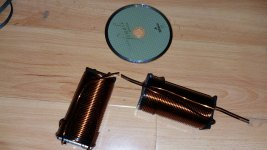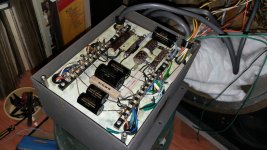I would like to replace the original JBL 4343 woofer inductor (5.4mH with 0.6ohm DCR) with a new 5.4mH at 0.25 ohm DCR, whic is about tripple the size of the original inductor. It gonna be a big task to install inside the 4343 because the new inductor is very big with 2mm diameter wire
My intention is to improve the bass response (more bass and more bass dynamic)
Is this approach effective to achieve the goal?
My intention is to improve the bass response (more bass and more bass dynamic)
Is this approach effective to achieve the goal?
Attachments
Kind of sort of.
The issues is that well designed, you take the DCR of the coil into account when you build the entire crossover network. In my designs, this would mean I'd have to change the coil and cap values to achieve the exact same FR.
Usually, reducing DCR in the first coil tilts the FR of the woofer upwards.
Sometimes you can even use DCR to help in eliminating baffle step.
I don't know how much of a difference 0.35 Ohms will make in your case, but the increased output wont' be in the bottom half, but the top half of the woofer's range.
The issues is that well designed, you take the DCR of the coil into account when you build the entire crossover network. In my designs, this would mean I'd have to change the coil and cap values to achieve the exact same FR.
Usually, reducing DCR in the first coil tilts the FR of the woofer upwards.
Sometimes you can even use DCR to help in eliminating baffle step.
I don't know how much of a difference 0.35 Ohms will make in your case, but the increased output wont' be in the bottom half, but the top half of the woofer's range.
You make a lower DCR inductor by using thicker wire.
Yes, it is the same theory and it does not work well for this because of what I shared with you. Change the DCR and you change the behavior of the low pass filter and not how you want. When I make crossover filters I choose the ideal DCR. I do not pick the minimum DCR available to me unless it is also the ideal DCR. It is not a cost factor. It is a matter of making the ideal low pass circuit. Alter the DCR and you alter the entire circuit.
You can't pick and choose what parts of network circuit theory you believe.
If you want to avoid this altogether you need to build an active crossover so the amp has no coils or caps between it and the woofer.
You might as well just start doubling the inductors or cap values as well if you do this.
Best,
Erik
Yes, it is the same theory and it does not work well for this because of what I shared with you. Change the DCR and you change the behavior of the low pass filter and not how you want. When I make crossover filters I choose the ideal DCR. I do not pick the minimum DCR available to me unless it is also the ideal DCR. It is not a cost factor. It is a matter of making the ideal low pass circuit. Alter the DCR and you alter the entire circuit.
You can't pick and choose what parts of network circuit theory you believe.
If you want to avoid this altogether you need to build an active crossover so the amp has no coils or caps between it and the woofer.
You might as well just start doubling the inductors or cap values as well if you do this.
Best,
Erik
Last edited:
Best not to compare using thick wire to wind an inductor with using thick loudspeaker cable. Using thicker wire in either case introduces less resistance, but will not necessarily improve the bass in the way you desire.
As Erik says, changing the inductors may even have a detrimental effect on the sound of your speakers as the crossovers were designed with the original inductors in mind. I do not recommend that you change the inductors.
As Erik says, changing the inductors may even have a detrimental effect on the sound of your speakers as the crossovers were designed with the original inductors in mind. I do not recommend that you change the inductors.
In a word - no.My intention is to improve the bass response (more bass and more bass dynamic). Is this approach effective to achieve the goal?
>>but the increased output wont' be in the bottom half, but the top half of the woofer's range
Why is that, the increased output is supposed to spread equally throughout the bass region?
If all the other components in the network were resistors, then no problem. But they are not. Each reactive component's impedance (coils and caps) changes vs. frequency, therefore the percent effect of DCR is not the same.
You can view this in simulation. See the top link on this page:
A Speaker Maker's Journey: LM-1 Bookshelf Crossover
You can grab XSim, and this simulation, and play with DCR.
I think part of what you are missing is that the low pass filter is ALSO an equalizer.
Usually woofer response rises with frequency. So the low pass filter doesn't just cut off the response at a certain point, but it also has to tilt the response downwards.
Change DCR and you change this tilt.Eliminate DCR you point the response upwards which increases the midrange, not the bass. Do this enough and you have to re-set the twitter level.
DCR is not a separate part of the circuit you can just alter without affecting everything else.
If you want a bassier speaker, decrease the treble.
Usually woofer response rises with frequency. So the low pass filter doesn't just cut off the response at a certain point, but it also has to tilt the response downwards.
Change DCR and you change this tilt.Eliminate DCR you point the response upwards which increases the midrange, not the bass. Do this enough and you have to re-set the twitter level.
DCR is not a separate part of the circuit you can just alter without affecting everything else.
If you want a bassier speaker, decrease the treble.
Last edited:
There used to be a thing, and you'll know if you've listened to a low feedback amp with an output transformer that different taps change the bass. Sometimes the Q becomes too high and it doesn't sound optimum.
The bass is a combination of the driver mechanically and the box, and the driver electrically and the amp and crossover but the electrical damping involves these three in series. It is hard to compete with 6 ohms of driver resistance when lowering the DCR of a coil. It may sound a little different.
The bass is a combination of the driver mechanically and the box, and the driver electrically and the amp and crossover but the electrical damping involves these three in series. It is hard to compete with 6 ohms of driver resistance when lowering the DCR of a coil. It may sound a little different.
The difference may be measured in a Lab, you will definitely hear no improvement, since difference in attenuation between 0.6 ohm in series with 8 ohm and 0.24 ohm in series with 8 ohm is microscopic, well under 1 dB , well below the threshold of hearing.
So you will spend $$, waste time and complicate your life trying to mount a larger and heavier inductor ... for no (audible) return.
For comparison, moving your speaker a couple inches closer or further from a wall will change way more than that, go figure.
Going from horrible to standard is one thing, going from "almost no attenuation" to "microscopically less" is what we are talking about on this particular case.
What you are quoting is a "blanket statement" , which must be qualified in each case.
So you will spend $$, waste time and complicate your life trying to mount a larger and heavier inductor ... for no (audible) return.
For comparison, moving your speaker a couple inches closer or further from a wall will change way more than that, go figure.
Who said that?I have always heard from people saying low DCR helping the bass performance, so no such thing?
Going from horrible to standard is one thing, going from "almost no attenuation" to "microscopically less" is what we are talking about on this particular case.
What you are quoting is a "blanket statement" , which must be qualified in each case.
- Status
- This old topic is closed. If you want to reopen this topic, contact a moderator using the "Report Post" button.
- Home
- Loudspeakers
- Multi-Way
- Does it improve the bass response if I replace the lower DCR woofer inductor

